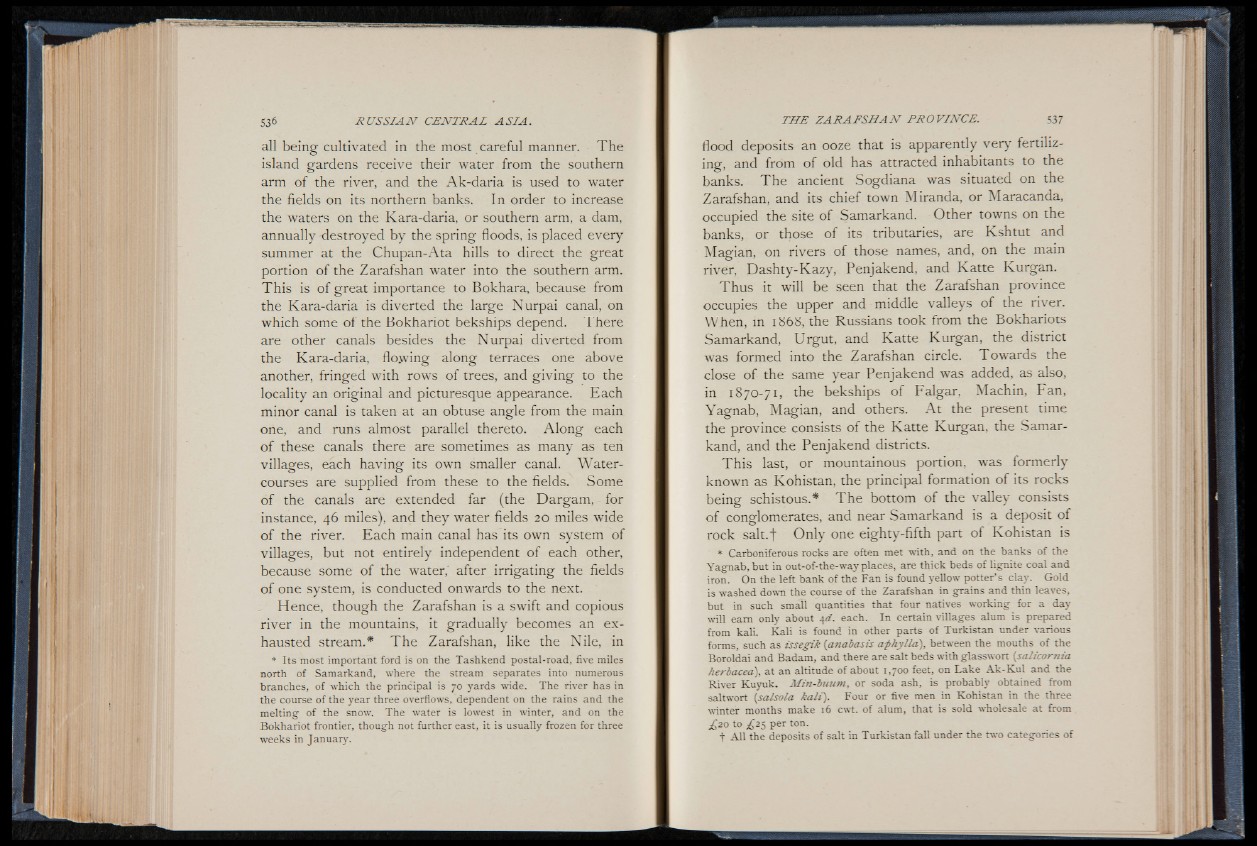
all being cultivated in the most careful manner. The
island gardens receive their water from the southern
arm of the river, and the Ak-daria is used to water
the fields on its northern banks. In order to increase
the waters on the Kara-daria, or southern arm, a dam,
annually destroyed by the spring floods, is placed every
summer at the Chupan-Ata hills to direct the great
portion of the Zarafshan water into the southern arm.
This is of great importance to Bokhara, because from
the Kara-daria is diverted the large Nurpai canal, on
which some of the Bokhariot bekships depend. There
are other canals besides the Nurpai diverted from
the Kara-daria, flowing along terraces one above
another, fringed with rows of trees, and giving to the
locality an original and picturesque appearance. Each
minor canal is taken at an obtuse angle from the main
one, and runs almost parallel thereto. Along each
of these canals there are sometimes as many as ten
villages, each having its own smaller canal. Water- C5 ’ O
courses are supplied from these to the fields. Some
of the canals are extended far (the Dargam, for
instance, 46 miles), and they water fields 20 miles wide
of the river. Each main canal has its own system of
villages, but not entirely independent of each other,
because some of the water,' after irrigating the fields
of one system, is conducted onwards to the next.
Hence, though the Zarafshan is a swift and copious
river in the mountains, it gradually becomes an exhausted
stream.* The Zarafshan, like the Nile, in
* Its most important ford is on the Tashkend postal-road, five miles
north of Samarkand, where the stream separates into numerous
branches, of which the principal is 70 yards wide. The river has in
the course of the year three overflows, dependent on the rains and the
melting of the snow. The water is lowest in winter, and on the
Bokhariot frontier, though not further east, it is usually frozen for three
weeks in January.
flood deposits an ooze that is apparently very fertilizing,
and from of old has attracted inhabitants to the
banks. The ancient Sogdiana was situated on the
Zarafshan, and its chief town Miranda, or Maracanda,
occupied the site of Samarkand. Other towns on the
banks, or those of its tributaries, are Kshtut and
Magian, on rivers of those names, and, on the main
river, Dashty-Kazy, Penjakend, and Katte Kurgan.
Thus it will be seen that the Zarafshan province
occupies the upper and middle valleys of the river.
When, in 1868, the Russians took from the Bokhariots
Samarkand, Urgut, and Katte Kurgan, the district
was formed into the Zarafshan circle. Towards the
close of the same year Penjakend was added, as also,
in 1870-71, the bekships of Falgar, Machin, Fan,
Yagnab, Magian, and others. A t the present time
the province consists of the Katte Kurgan, the Samarkand,
and the Penjakend districts.
This last, or mountainous portion, was formerly
known as Kohistan, the principal formation of its rocks
being schistous.* The bottom of the valley consists
of conglomerates, and near Samarkand is a deposit of
rock salt.f Only one eighty-fifth part of Kohistan is
* Carboniferous rocks are often met with, and on the banks of the
Ya gn ab, but in out-of-the-way places, are thick beds of lignite coal and
iron. On the left bank of the Fan is found yellow potter’ s clay. Gold
is washed down the course of the Zarafshan in grains and thin leaves,
but in such small quantities that four natives working for a day
will earn only about 40?. each. In certain villages alum is prepared
from k a l i Kali is found in other parts o f Turkistan under various
forms, such as issegik (anabasis aphylla), between the mouths o f the
Boroldai and Badam, and there are salt beds with glasswort (salicornia
herbáceo), at an altitude of about 1,700 feet, on L ak e A k -K u l and the
River Kuyuk. Min-buum, or soda ash, is probably obtained from
saltwort (salsola kali). Four or five men in Kohistan in the three
winter months make 16 cwt. of alum, that is sold wholesale at from
¿20 to Z 25 Per ton.
t A ll the deposits of salt in Turkistan fall under the two categories of